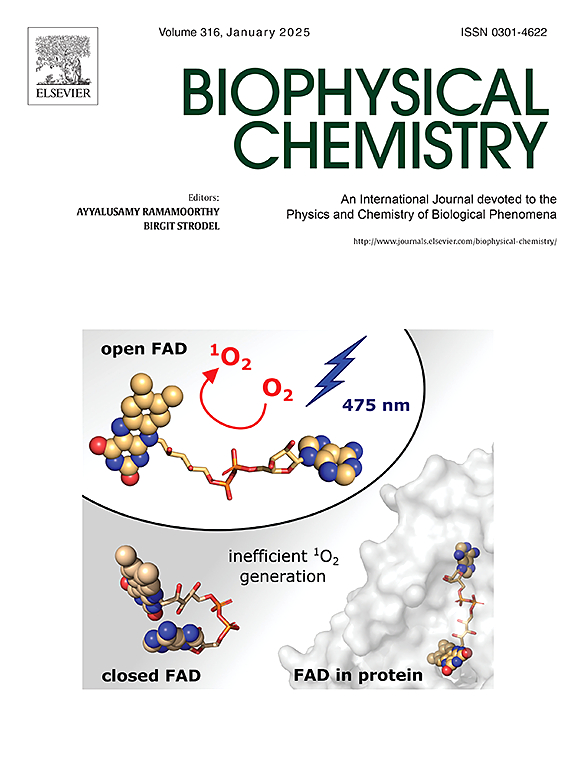Equilibrium solubility, solvent effect, solvation and thermodynamic modeling of 1, 3-dinitropyrazole in solutions of methyl alcohol /ethyl alcohol + water
IF 2.2
3区 生物学
Q2 BIOCHEMISTRY & MOLECULAR BIOLOGY
引用次数: 0
Abstract
1,3-dinitropyrazole's (DNP) solubility was studied by utilizing the gravimetric method across temperatures ranging 278.15 to 318.15 K and a pressure of 101.2 kPa. In the study, two solvent mixtures were investigated: aqueous methyl alcohol and aqueous ethyl alcohol. Based on the findings, higher temperatures favorably influenced solute dissolution in both solvent systems. To relate the solubility of DNP in two binary solvents mixture, the KAT-LSER model was used. This implies that the polarity of the solvents, as well as the cavity term and hydrogen bonding interactions were pivotal to DNP's solubility. By utilizing the Jouyban-Acree, van't Hoff-Jouyban-Acree, Apelblat-Jouyban-Acree and Ma models, the derived results were compiled. The experimental results prove that the Apelblat-Jouyban-Acree model could give the best correlation results with the experimental data, with the overall relative average deviation values (RAD) of 2.05 %, 2.51 % and the root mean-square deviation (RMSD) of 0.415 × 10−4, 0.492 × 10−4 in aqueous methyl alcohol and aqueous ethyl alcohol, respectively. Using the inverse Kirkwood–Buff integrals method, the preferential solvation parameters for the solute DNP determined. The obtained results show that DNP exhibited a preference for solvation in methyl alcohol and ethyl alcohol at all mole fractions of alcohol.

1,3 -二硝基吡唑在甲醇/乙醇+水溶液中的平衡溶解度、溶剂效应、溶剂化和热力学模型
用重量法研究了1,3-二硝基吡唑(DNP)在278.15 ~ 318.15 K温度和101.2 kPa压力下的溶解度。在研究中,研究了两种溶剂混合物:含水甲醇和含水乙醇。根据研究结果,较高的温度有利于两种溶剂体系中的溶质溶解。为了研究DNP在两种二元溶剂混合物中的溶解度,采用了KAT-LSER模型。这意味着溶剂的极性,以及空腔期和氢键相互作用对DNP的溶解度至关重要。利用Jouyban-Acree、van't Hoff-Jouyban-Acree、Apelblat-Jouyban-Acree和Ma模型,对推导结果进行了编译。实验结果表明,apelblat - jouybana - acree模型与实验数据的相关性最好,在甲醇水溶液和乙醇水溶液中,其总体相对平均偏差(RAD)分别为2.05%、2.51%,均方根偏差(RMSD)分别为0.415 × 10−4、0.492 × 10−4。利用逆Kirkwood-Buff积分法,确定了溶质DNP的首选溶剂化参数。结果表明,DNP在乙醇的所有摩尔分数中均表现出对甲醇和乙醇溶剂化的偏好。
本文章由计算机程序翻译,如有差异,请以英文原文为准。
求助全文
约1分钟内获得全文
求助全文
来源期刊

Biophysical chemistry
生物-生化与分子生物学
CiteScore
6.10
自引率
10.50%
发文量
121
审稿时长
20 days
期刊介绍:
Biophysical Chemistry publishes original work and reviews in the areas of chemistry and physics directly impacting biological phenomena. Quantitative analysis of the properties of biological macromolecules, biologically active molecules, macromolecular assemblies and cell components in terms of kinetics, thermodynamics, spatio-temporal organization, NMR and X-ray structural biology, as well as single-molecule detection represent a major focus of the journal. Theoretical and computational treatments of biomacromolecular systems, macromolecular interactions, regulatory control and systems biology are also of interest to the journal.
 求助内容:
求助内容: 应助结果提醒方式:
应助结果提醒方式:


